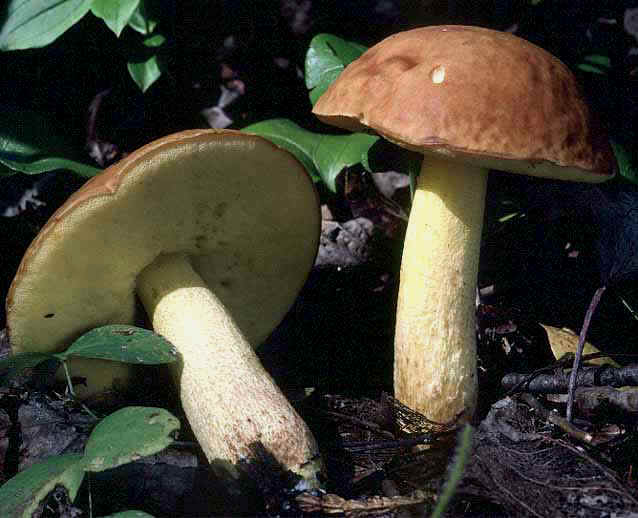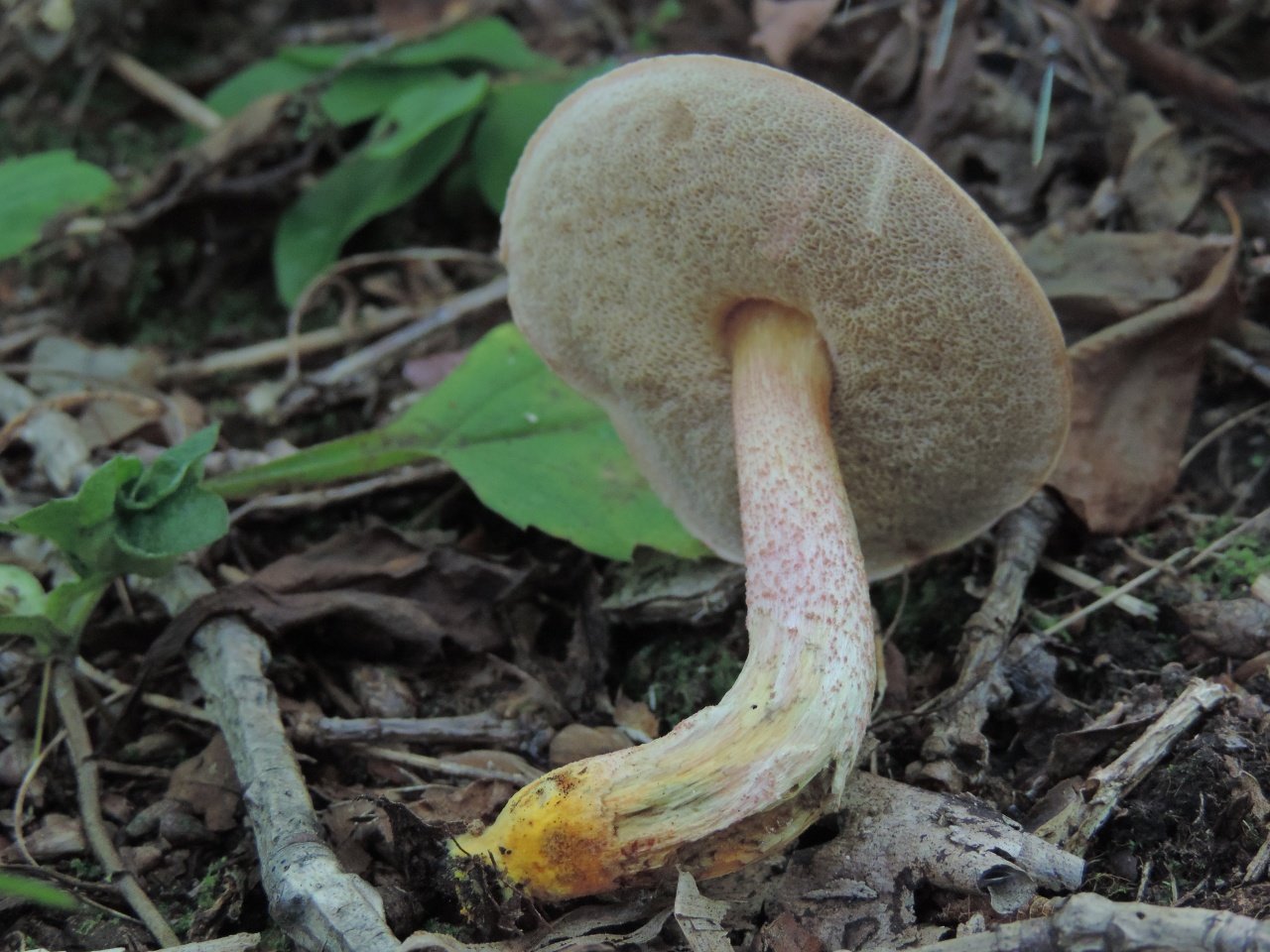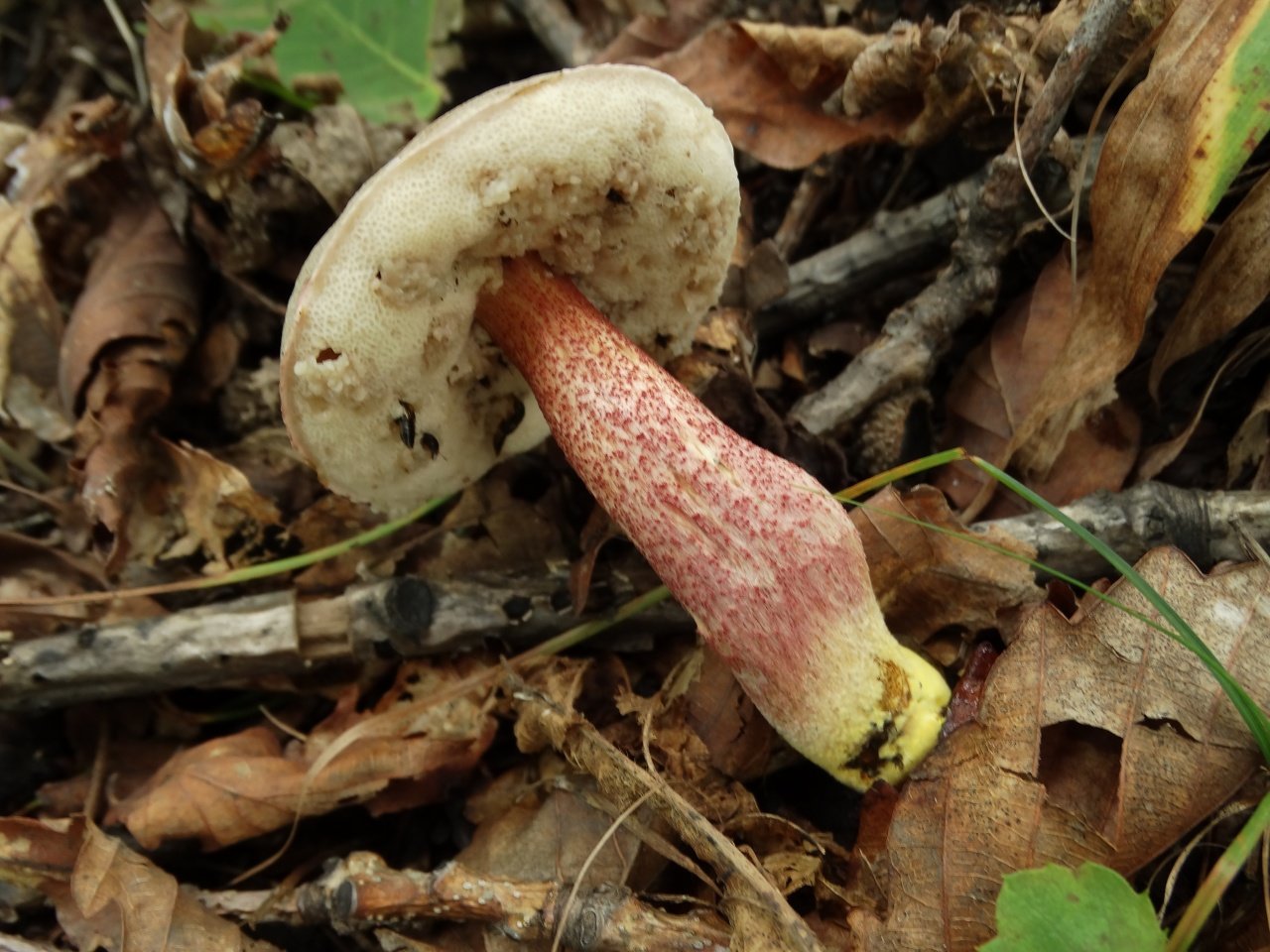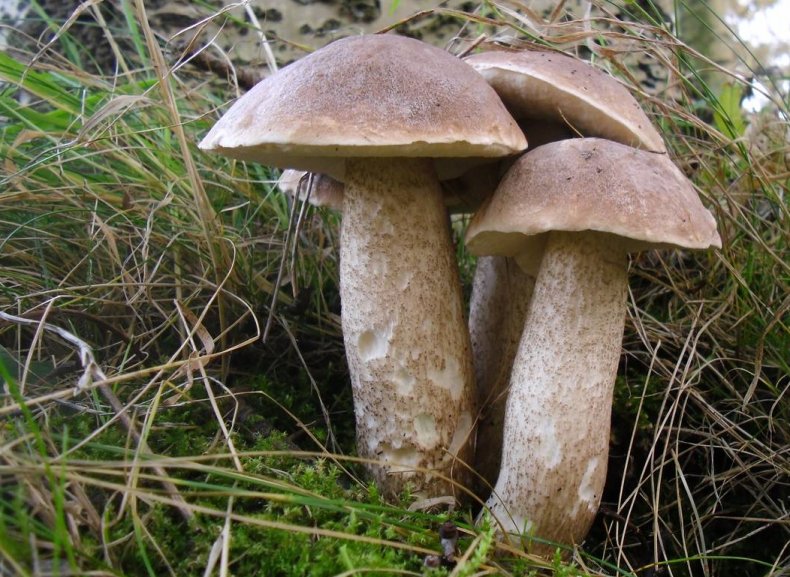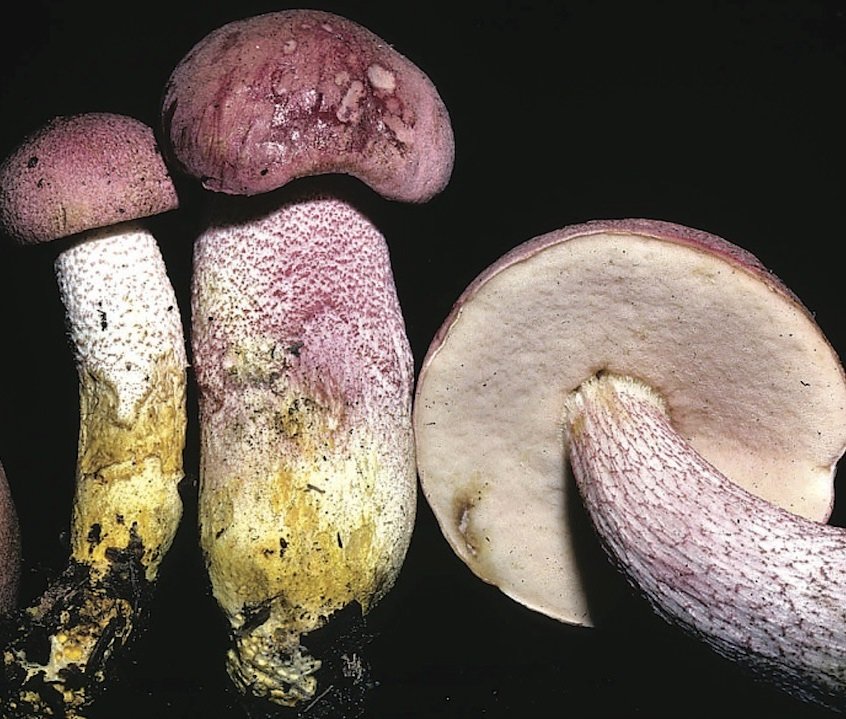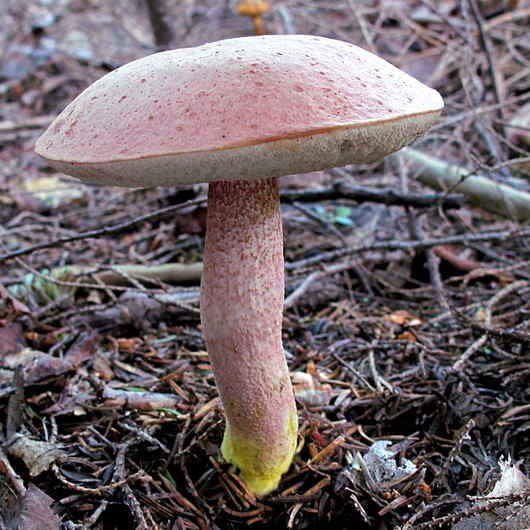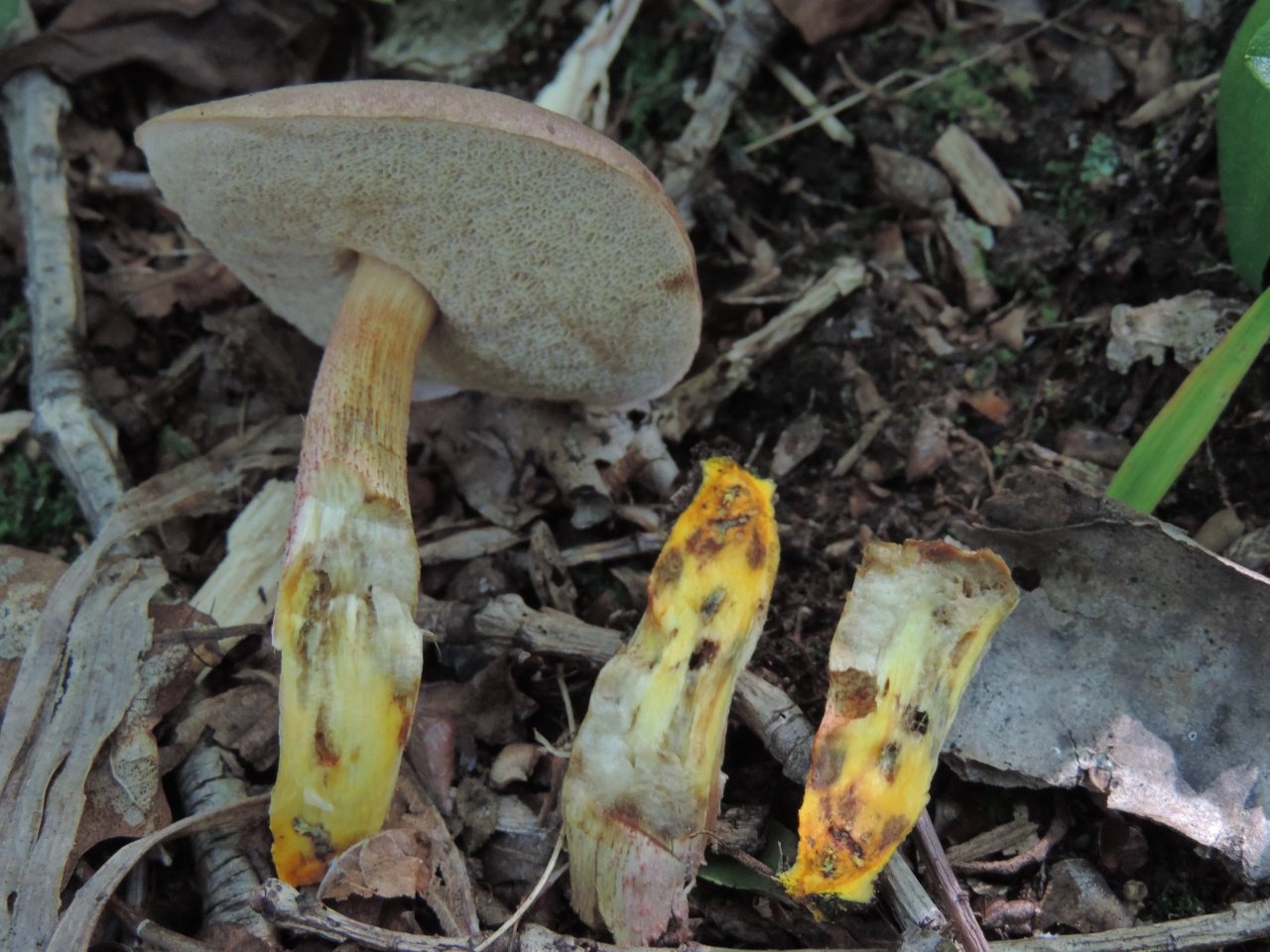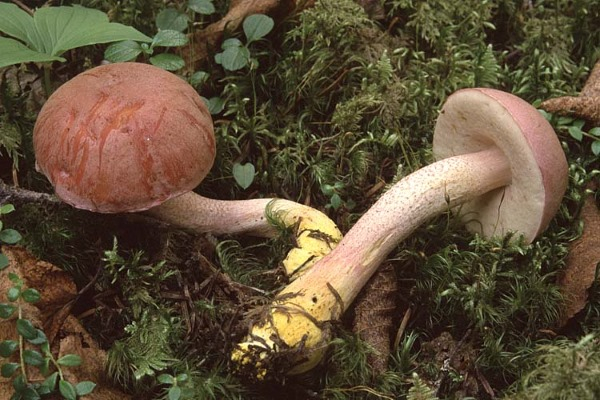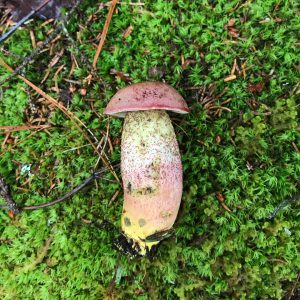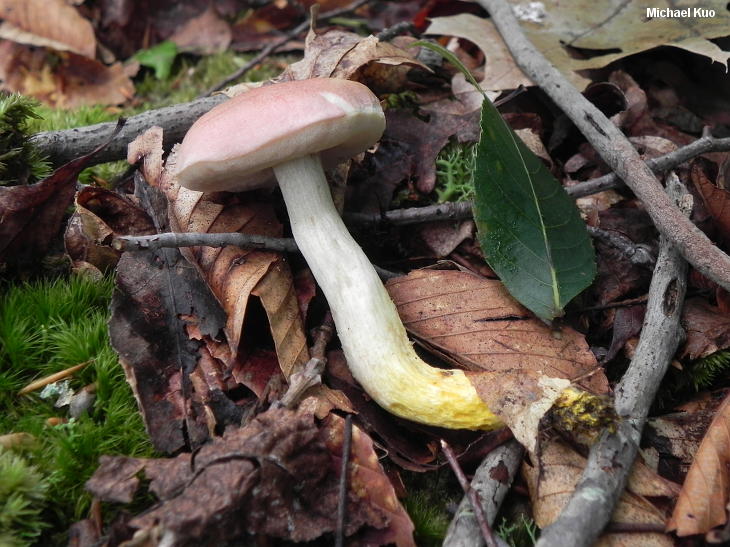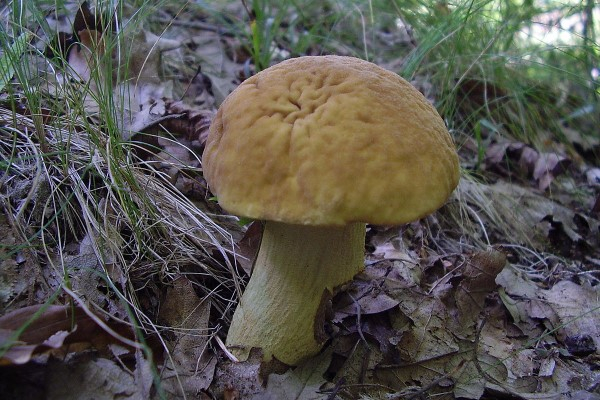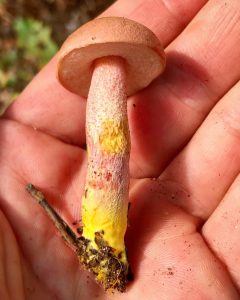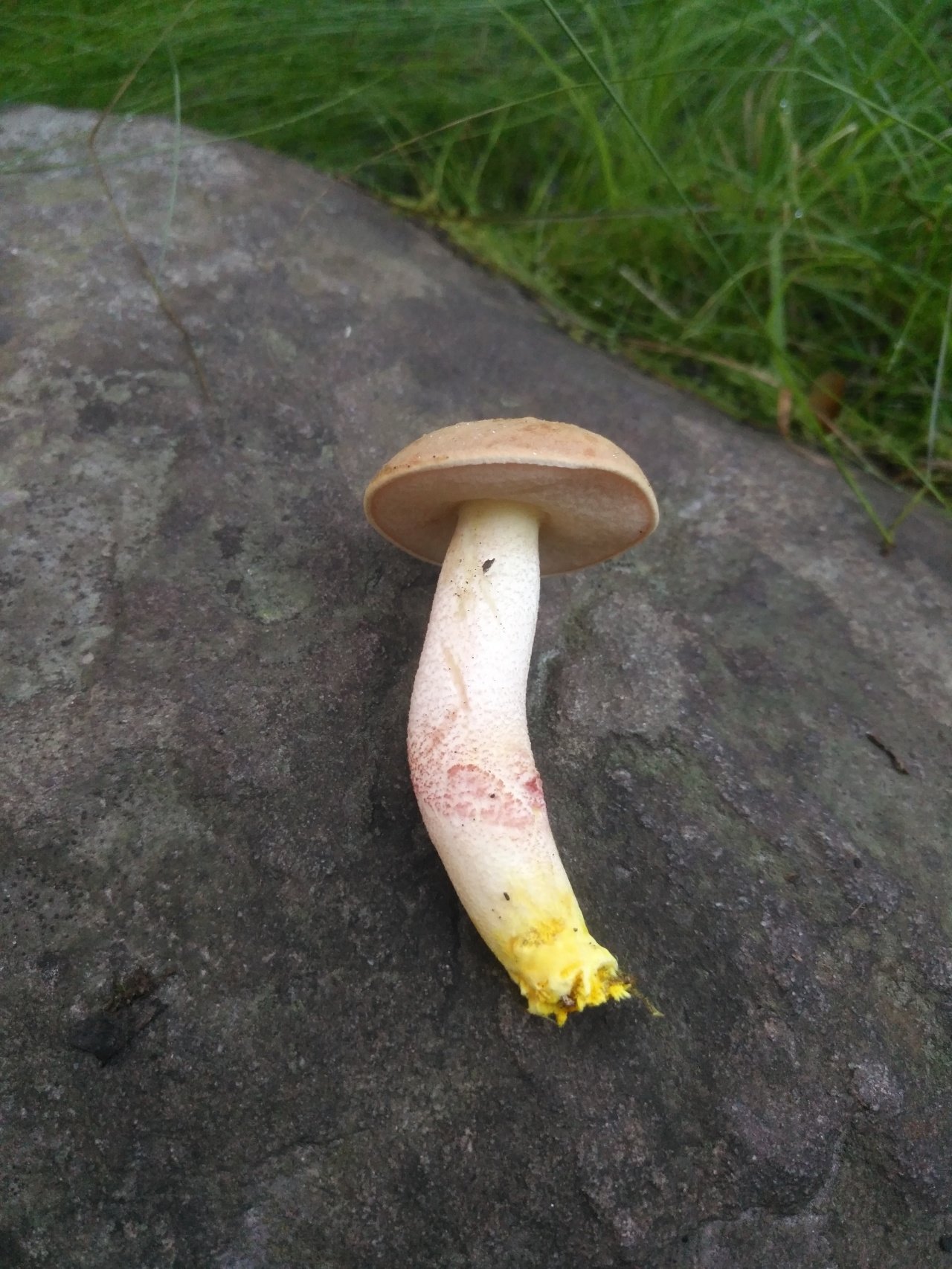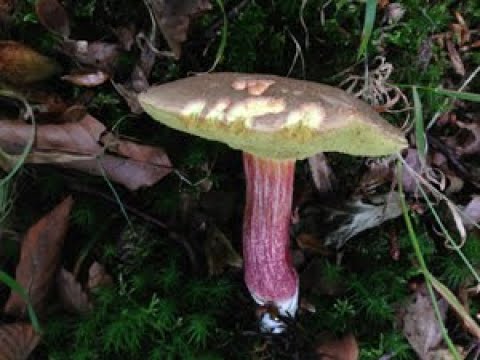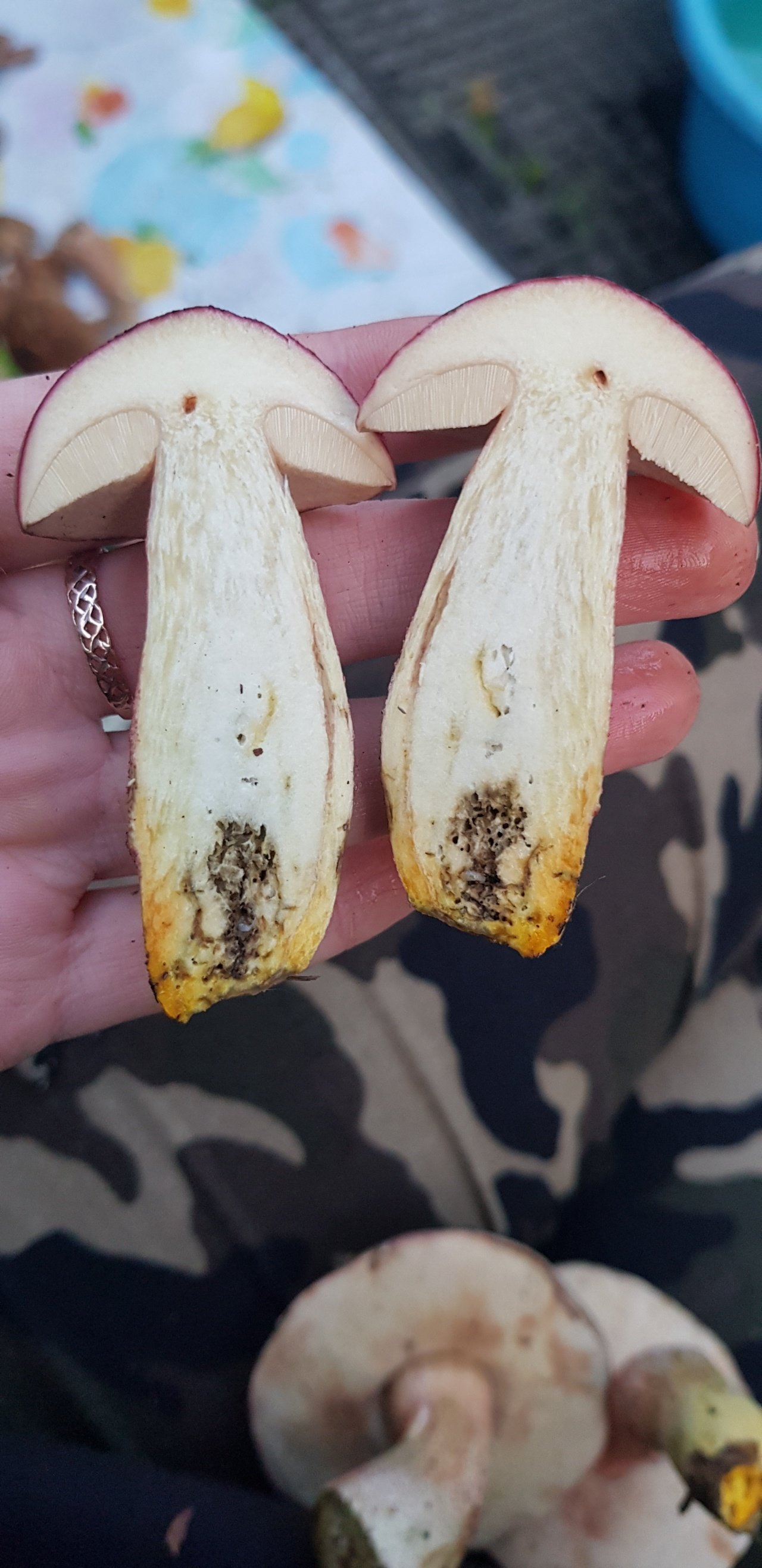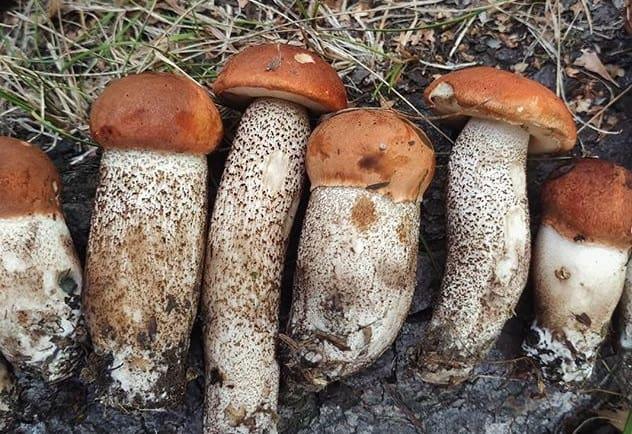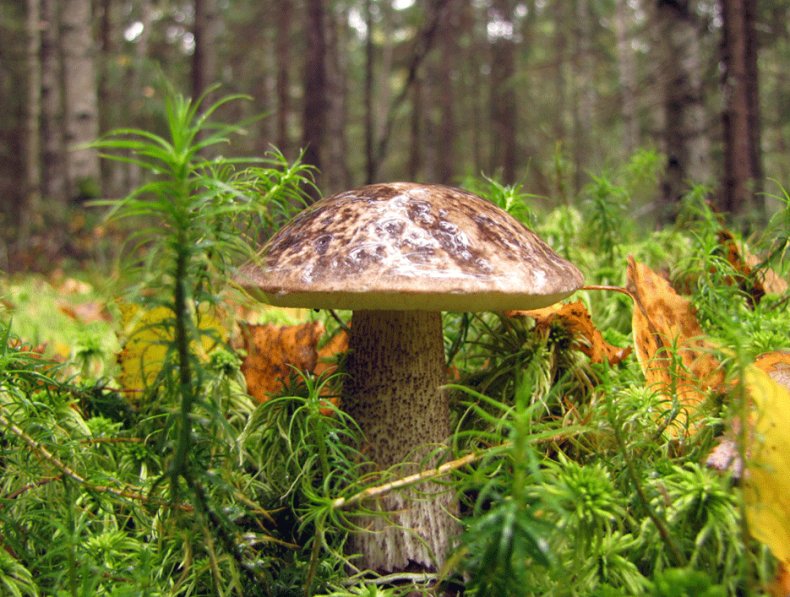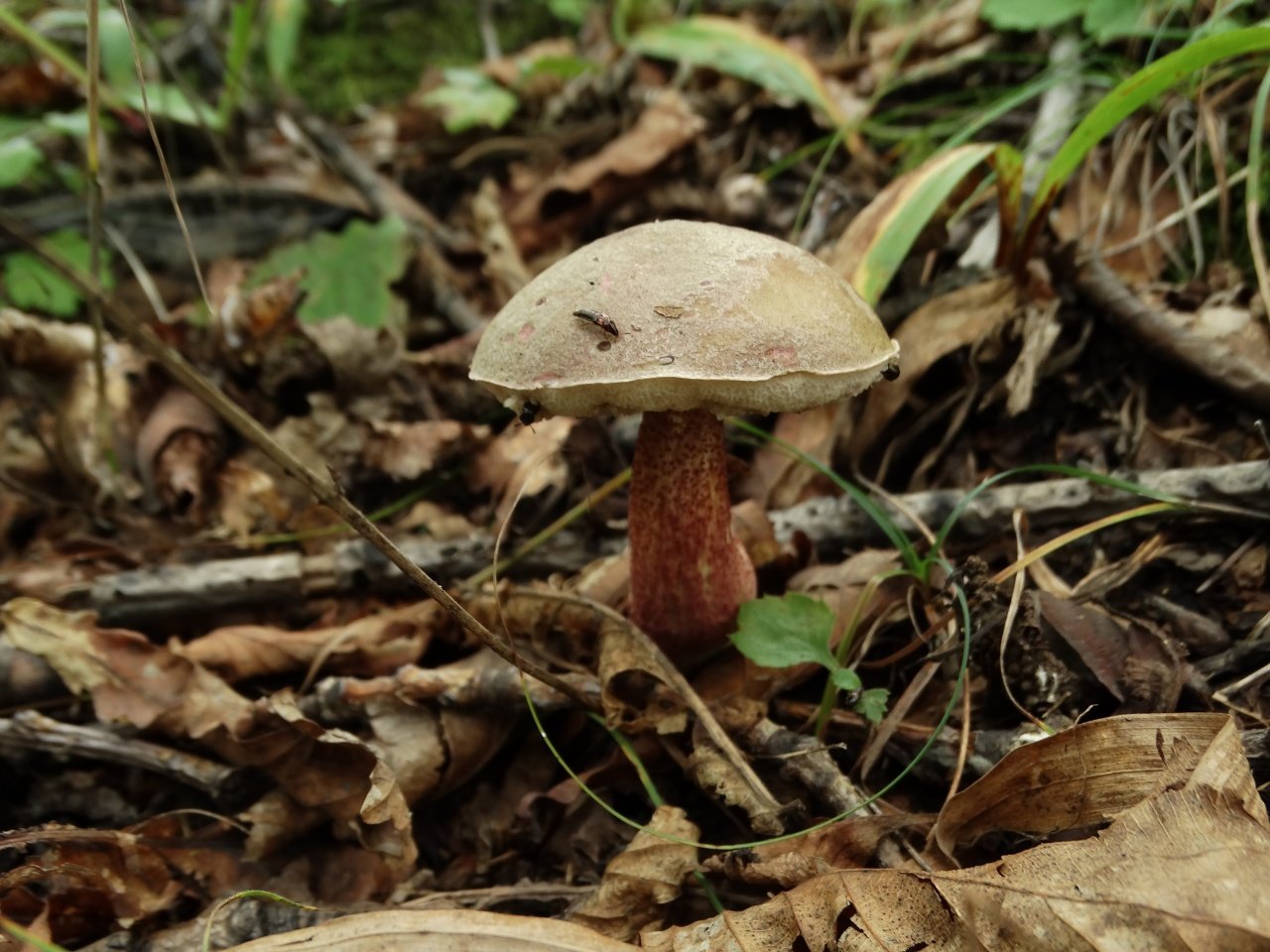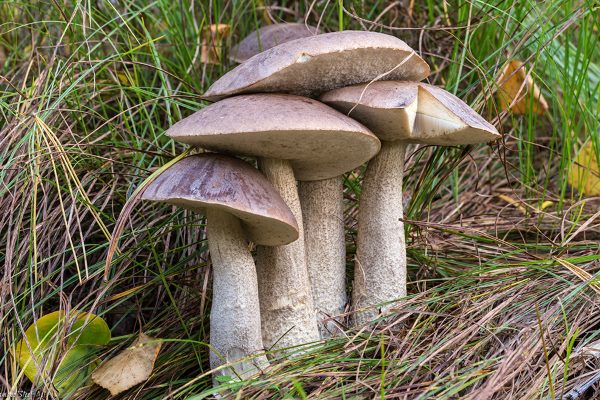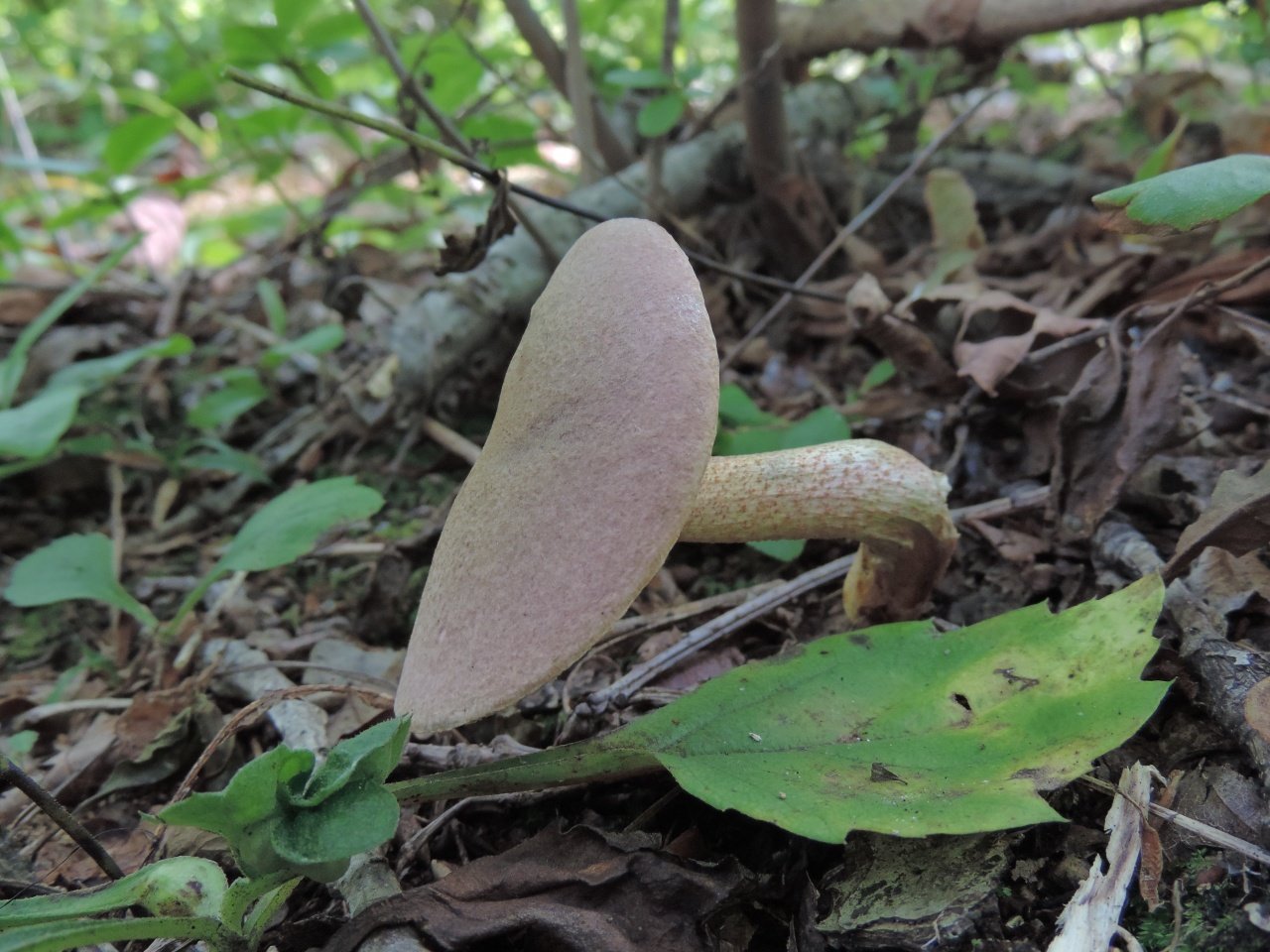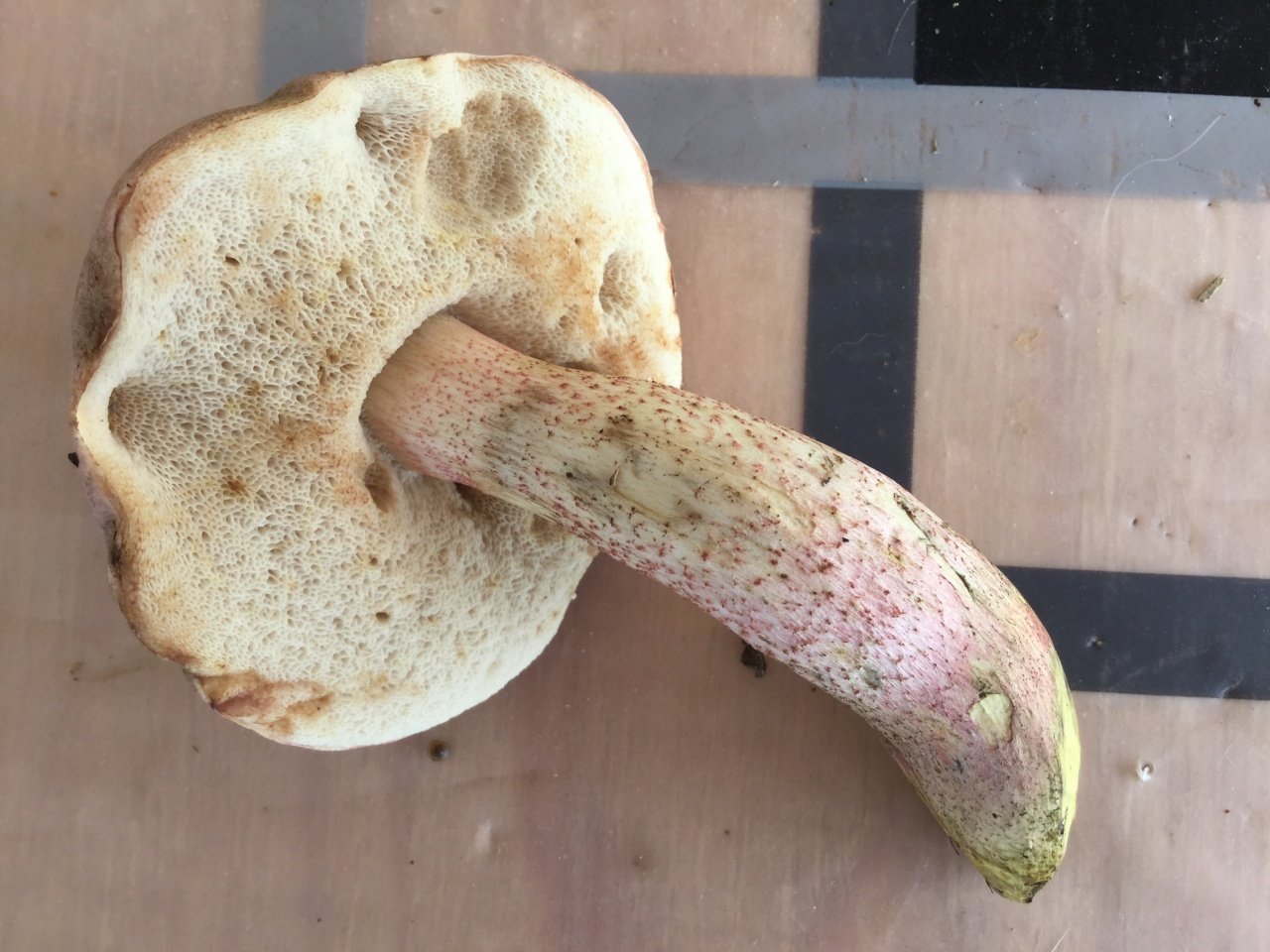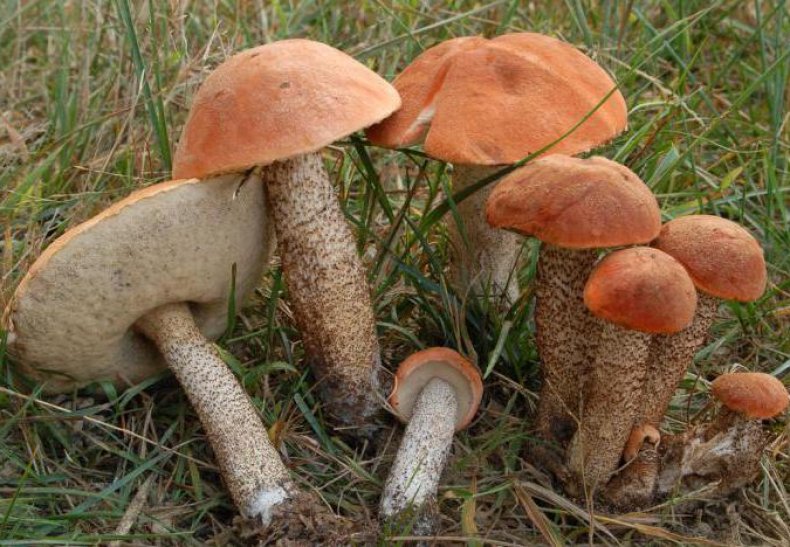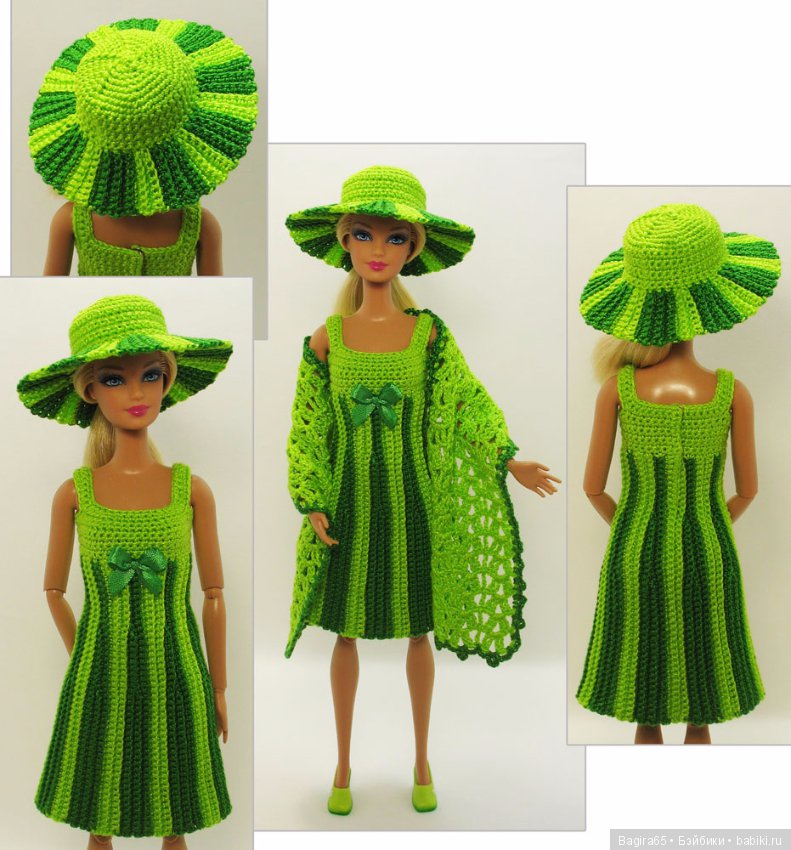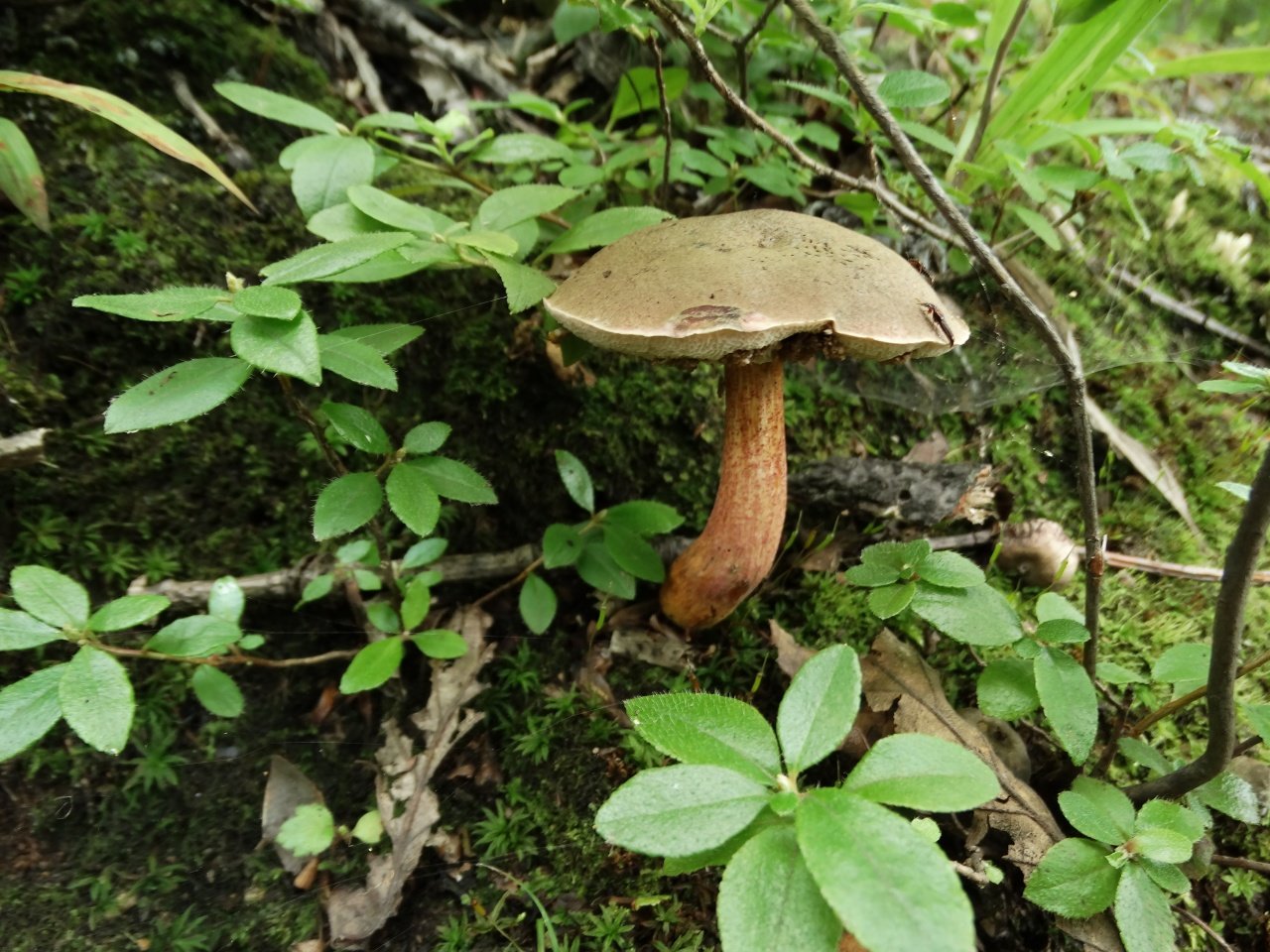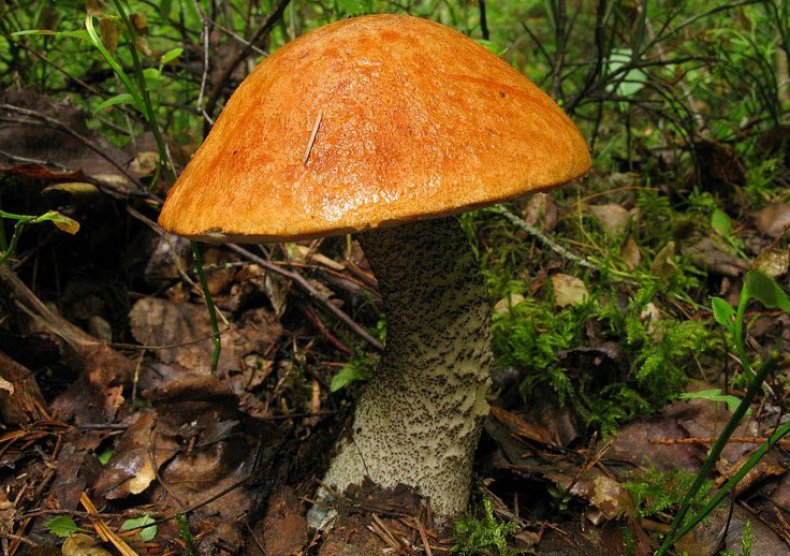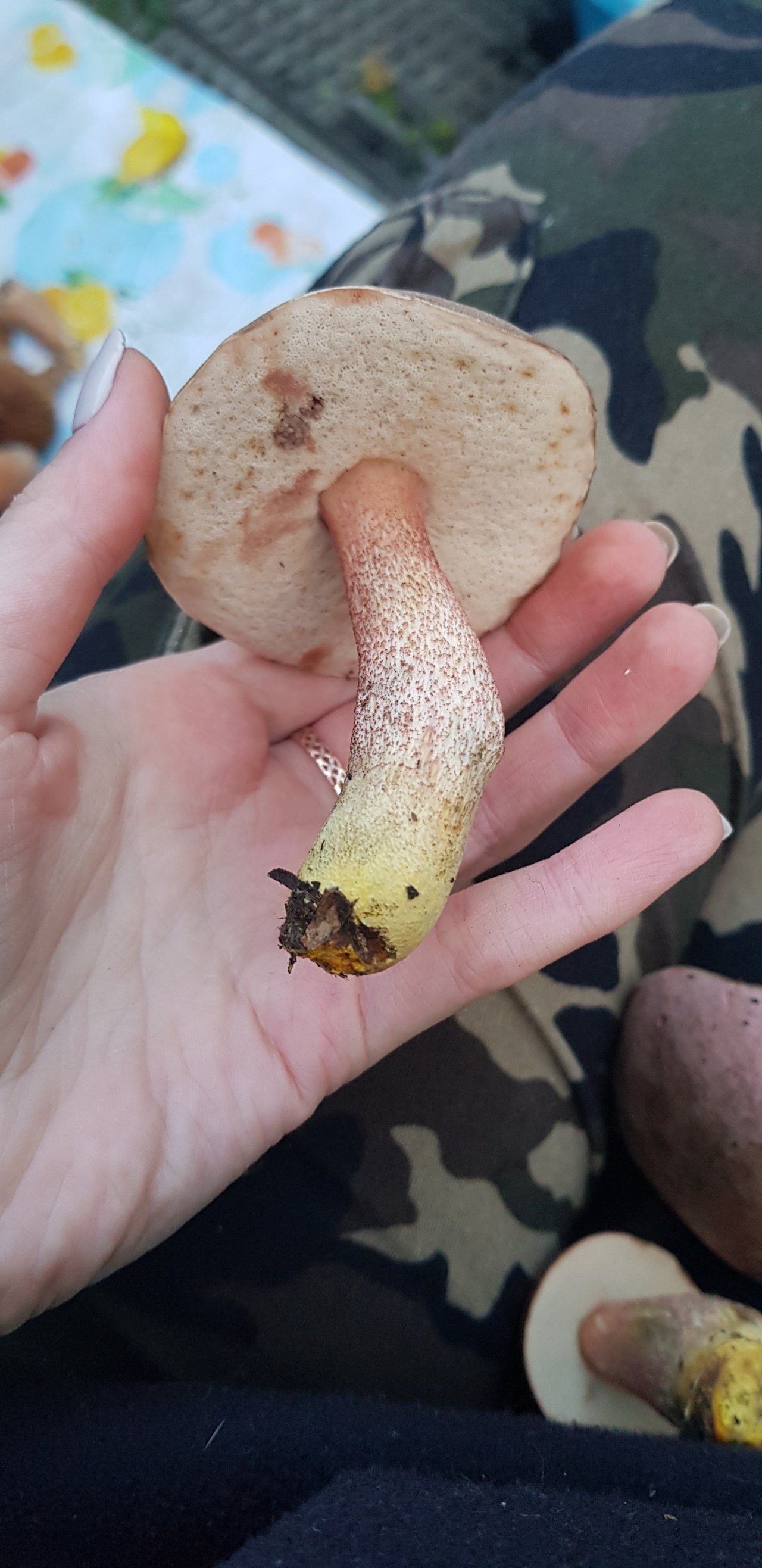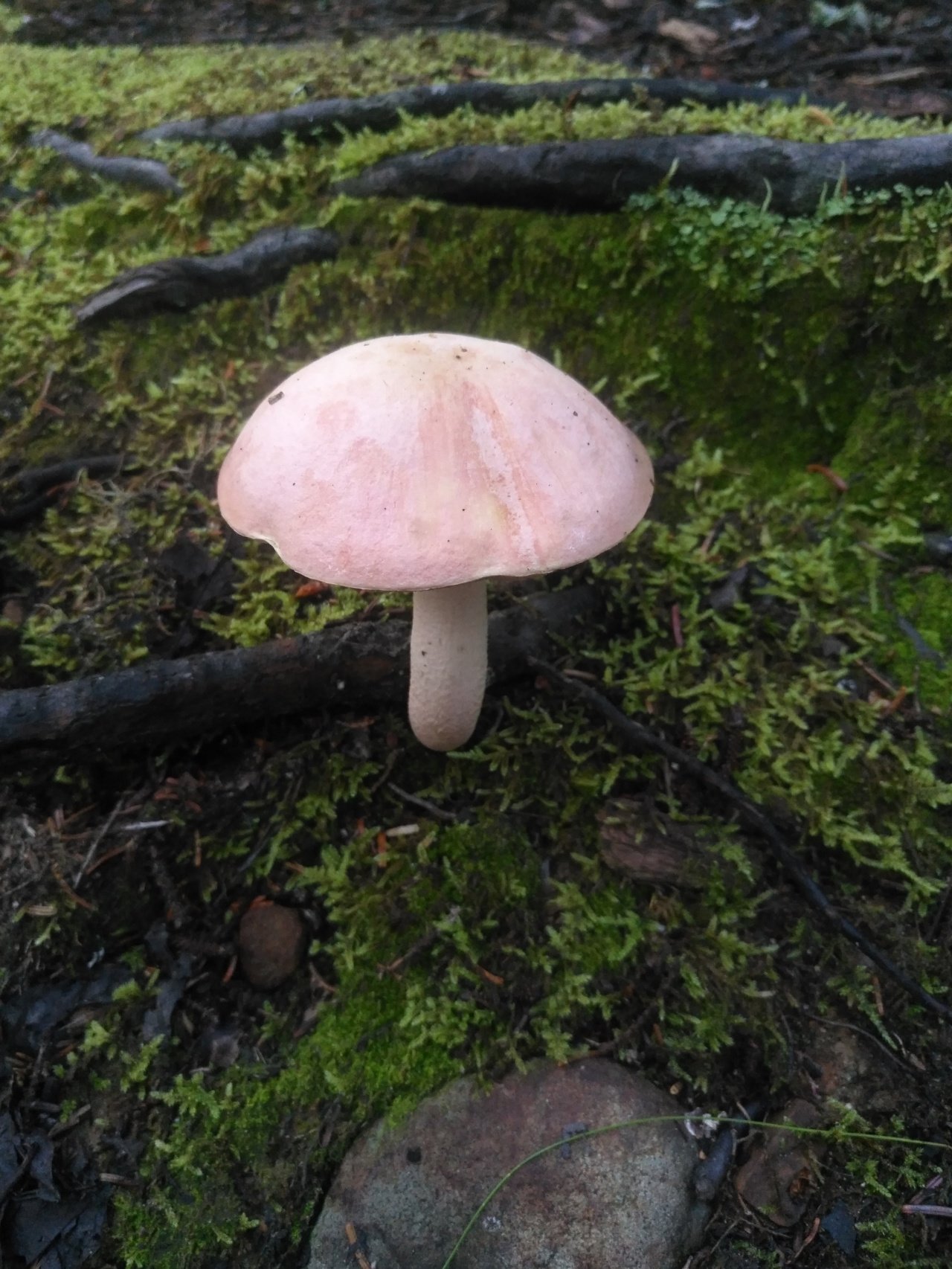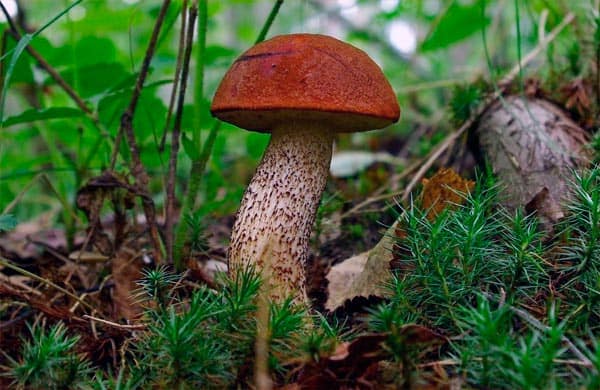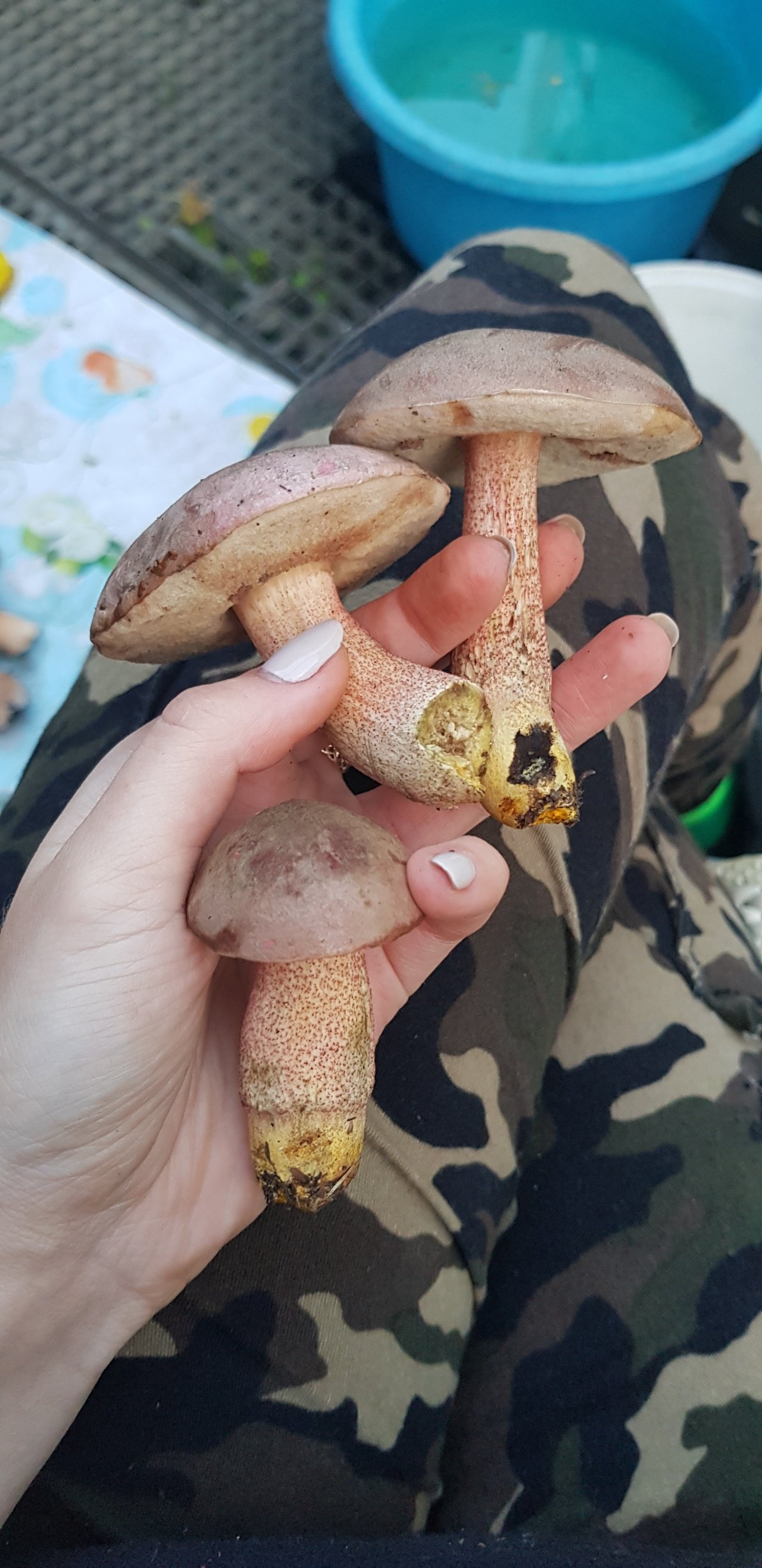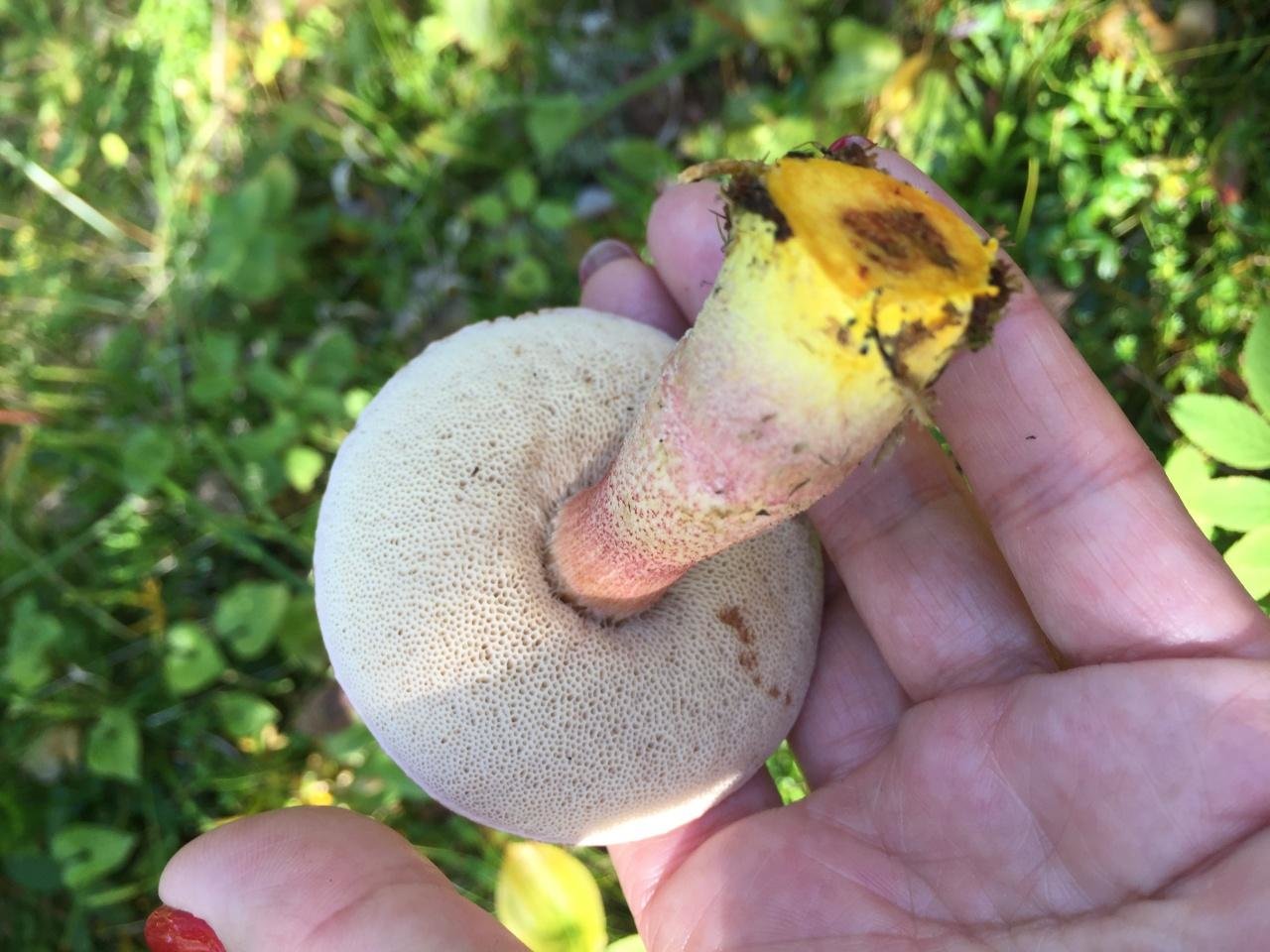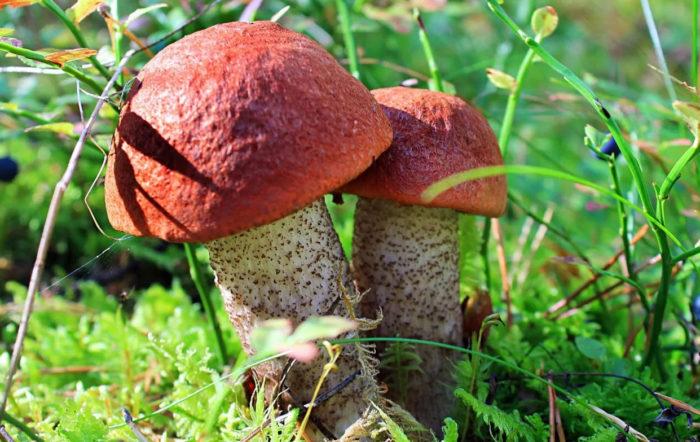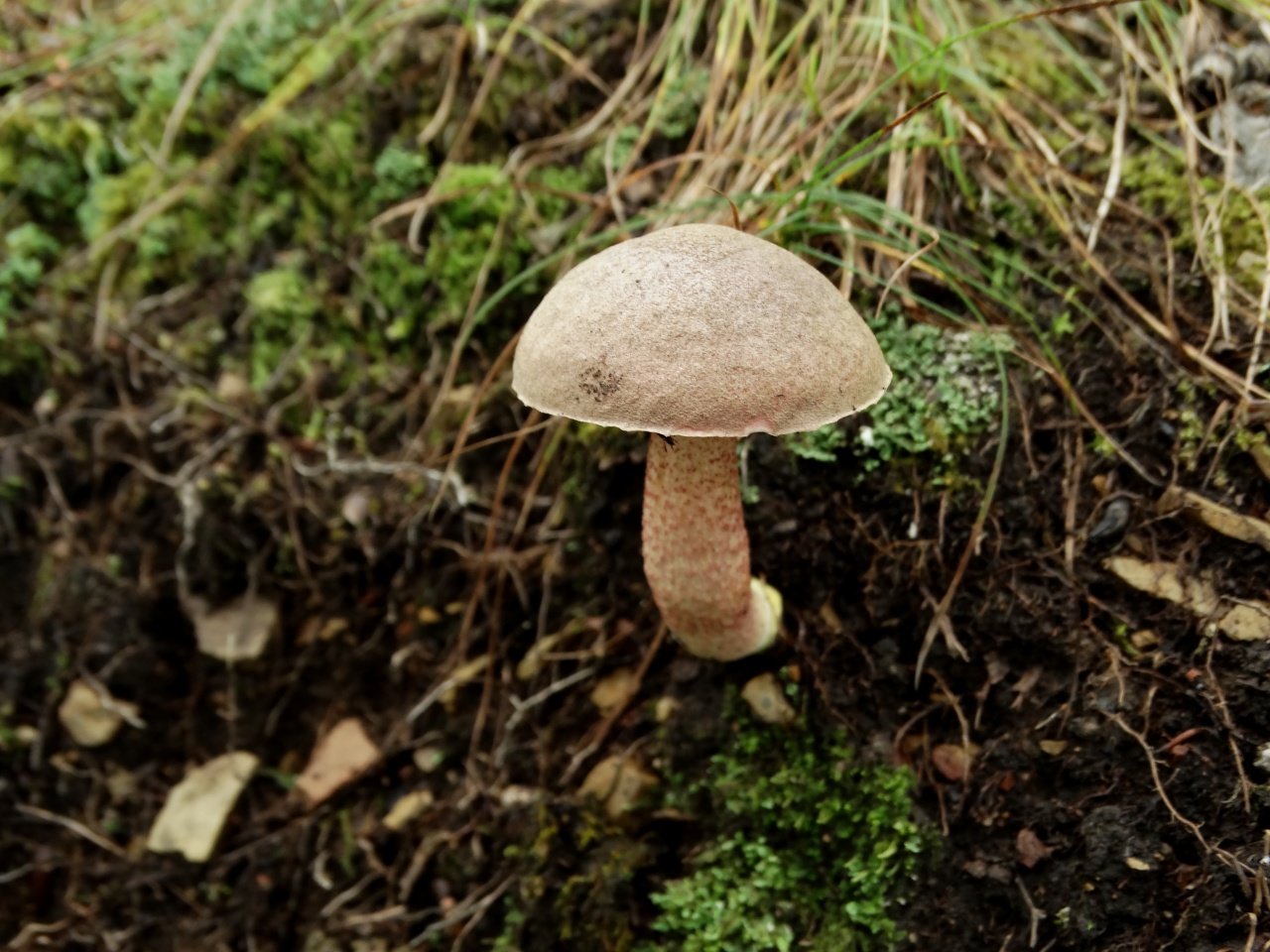Description of the Far Eastern
The cap diameter of this large mushroom can be up to 25 centimeters. The color of the cap is ocher-yellow. At a young age, the shape of the cap looks like a ball; in mature specimens, the caps become pillow-shaped, convex. The surface of the cap has radial wrinkles. Remnants of the bedspread are visible along the edges of the cap. The lower part of the cap is tubular, next to the stem, the tubes are dented.

In dry weather, the skin of the cap cracks. In young specimens, the tubular layer is yellow, but with age it becomes olive yellow. Spore powder of yellowish ocher color. In young butters, the flesh is dense, but when ripe it becomes loose. The color of the flesh is off-white. At the break, the pulp becomes pink. Spores are fusiform, pale brown.
The leg of the Far East is cylindrical, solid and strong, its surface is covered with small brown scales, and its general background is ocher. The scales are composed of hyphae bundles. The length of the leg reaches 13 centimeters, while the thickness is quite large - 2-3.5 centimeters.
Growing places of the Far Eastern limbs
Far Eastern limbs are found in the southern part of Primorsky Krai. These mushrooms grow in oak forests. In some places they are quite abundant.

Other mushrooms of this genus
Colored-legged boletus or Colored-legged boletus is a conditionally edible mushroom. It easily differs from other obabkov due to its pinkish color of the cap and yellow leg with pink scales. The diameter of the cap is 3-11 centimeters. Its shape is cushion-shaped. The leg is 6-11 centimeters long and 1-2 centimeters thick.
Colored-legged stumps with birches and oaks grow. These mushrooms are widespread in North America and Asia. In our country, they are known in the Far East and Siberia. They bear fruit from July to September.

Colored limbs in taste quality belong to the 2nd category. First and second courses are prepared from them. During processing, the white pulp turns black.
Blackened butcher is an edible mushroom. The fruit body is yellowish. The scales are arranged in rows on the leg. The pulp at the break turns red, and then turns black.
Mushrooms grow next to beeches and oaks. They are known in Europe, the Caucasus and the Carpathians. They are eaten in dried and fresh form.
Grabovik or gray boletus is an edible mushroom. The diameter of the hornbeam head reaches 14 centimeters. At a young age, the shape of the cap is hemispherical, its edges are tucked up, over time, the cap reaches the cushion shape. Its surface is velvety, brown-gray or brown-olive. The leg has a cylindrical shape, it thickens at the base.

The length of the leg is 13 cm, and the thickness reaches 4 cm. The color of the upper part of the leg is gray-olive, and the lower one is brown. It is covered with white scales, which become yellowish over time, and then dark brown. Graboviks grow in the Caucasus. They bear fruit from June to October. Most often, these mushrooms grow under hornbeams, which is where their name comes from. These mushrooms are boiled, pickled, dried, salted and fried.
Obobok (Leccinum scabrum)
- Other names for the mushroom:
- Birch
- Beryozovik
- Common boletus
Synonyms:
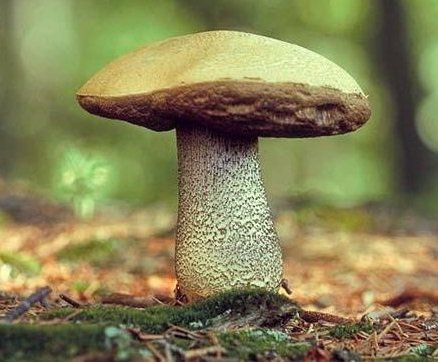
Hat:
In Obabok, the cap can vary from light gray to dark brown (the color obviously depends on the growing conditions and the type of tree with which the mycorrhiza is formed). The shape is semi-spherical, then pillow-shaped, naked or thin-clotted, up to 15 cm in diameter, slightly mucous in wet weather. The pulp is white, does not change color or slightly turns pink, with a pleasant "mushroom" smell and taste. In old mushrooms, the pulp becomes very spongy, watery.
Spore-bearing layer:
White, then dirty gray, the tubes are long, often eaten by someone, easily separated from the cap.
Spore powder:
Olive brown.
Leg:
The length of Obabok's leg can reach 15 cm, diameter up to 3 cm, solid. The shape of the stem is cylindrical, slightly widened at the bottom, gray-whitish, covered with dark longitudinal scales. The pulp of the leg with age becomes woody-fibrous, tough.
Spreading:
Obabok (Leccinum scabrum) grows from early summer to late autumn in deciduous (preferably birch) and mixed forests, in some years it is very abundant. Sometimes found in surprising quantities in spruce plantings interspersed with birch. It gives good yields in very young birch forests, appearing there almost the first among commercial mushrooms.
Similar species:
The genus Obaboks has many species and subspecies, many of them are very similar to each other. The main difference between boletus boletus (a group of species united under this name) and boletus boletus (another group of species) is that boletus boletus turn blue at the break, while boletus boletus does not. Thus, it is easy to distinguish between them, although the meaning of such an arbitrary classification is not entirely clear to me. Moreover, in fact, there are actually enough among the "boletus" and species that change color - for example, pink boletus (Leccinum oxydabile). In general, the further into the forest, the more varieties of paints.
It is more useful to distinguish Obabok (and all decent mushrooms) from the gall fungus. The latter, in addition to the disgusting taste, is distinguished by the pinkish color of the tubes, a special "greasy" texture of the pulp, a peculiar mesh pattern on the leg (the pattern is like that of a porcini mushroom, only dark), a tuberous leg, unusual places of growth (around stumps, near ditches, in dark conifers forests, etc.). In practice, confusing these mushrooms is not dangerous, but offensive.
Edibility:
Obobok - Normal edible mushroom. Some (Western) sources indicate that only the caps are edible, and the legs are supposedly too hard. Absurd! The prepared hats are just different with a nauseating gelatinous consistency, while the legs always remain strong, collected. The only thing that all reasonable people agree on is that the tubular layer of old mushrooms must be removed. (And, ideally, take it back to the forest.)
Author's notes: Despite the seeming routine, Obabok is a rather mysterious mushroom. First, fruiting. For several years it can grow in Homeric quantities everywhere and everywhere. In the early 90s, boletus was, without exaggeration, the most widespread mushroom in the Naro-Fominsk region. He was loaded with buckets, troughs, trunks. And in one year he disappeared, and he still does not exist. There were enough whites as they are (despite the crowds of greedy summer residents), and the boletus has disappeared. From time to time only monstrous freaks come across: small, thin, twisted.
In the summer of 2002, for obvious reasons, there were no mushroom pickers at all, and what do you think? from time to time we came across quite decent boletus boletus. Something will happen next time, I thought.
And the next time was not long in coming. The summer and autumn of 2003 turned out to be so fruitful that all speculation about the degeneration of the boletus can be safely sent to the dump of opinions. Obaboks started in June and walked and walked and walked without interruption until the beginning of October. The field, overgrown with young birches, was completely trampled by mushroom pickers - but without a bag of these Obaboks, not a single good person returned. The forest edges were cluttered with stools. Three times in a row (without missing a day) I could not get to the place where I expected to meet a black lump, my character let me down: I immediately grabbed all the young and strong Obaboks that I could only see, and after 100 meters my hike ended: it is banal not there were containers. I am sure that for many years the 2003 season will be remembered as a fairy tale, but then the sensations were different. It seemed that literally in front of my eyes the value of the boletus was being devalued.
Boletus (Leccinum variicolor)
or
Multicolored obobok
Hat:
Boletus has a multi-colored cap of a characteristic gray-whitish mouse color, painted with peculiar "strokes"; diameter - from about 7 to 12 cm, from hemispherical, closed to cushion, slightly convex; the mushroom is generally more "compact" than the common boletus, although not always. The flesh of the cap is white, slightly pink at the cut, with a faint pleasant smell.
Spore-bearing layer:
The tubes are finely porous, light gray in young fungi, acquire a gray-brown color with age, often become covered with darker spots; when pressed, it can also turn pink (or maybe, apparently, not turn pink).
Spore powder:
Light brown.
Leg:
10-15 cm in height and 2-3 cm in thickness (the height of the leg depends on the height of the moss over which the cap must be raised), cylindrical, somewhat thickening in the lower part, white, densely covered with black or dark brown streaky scales. The flesh of the leg is white, in older mushrooms it is highly fibrous, being cut off at the base, slightly blue.
Spreading:
Boletus multiforme bears fruit like its ordinary counterpart, from the beginning of summer to the end of October, forming mycorrhiza mainly with birch; found mainly in swampy areas, in mosses. In our area it is relatively rare, you see it infrequently, and in southern Russia, judging by eyewitness accounts, it is quite an ordinary mushroom.
Similar species:
It is difficult to understand boletus. The boletus themselves cannot do this. We will assume that the boletus is different from other representatives of the genus Leccinum in the striated color of the cap and slightly pinking flesh. There is also, however, the pink boletus (Leccinum oxydabile), which in this case is not clear what to do, there is a completely white Leccinum holopus. Distinguishing boletus is not so much a scientific question as an aesthetic one, and this must be remembered in order to find consolation on occasion.
Edible: Good mushroom, on par with boletus.
Remarks
It is always nice to add another type of boletus on the site. All the more so painted. We do not often come across such mushrooms that even in the pictures it is a pity to cut. And when you suddenly meet such people on the edge of a swamp, in thickets of soft fresh moss, for some reason you want to tumble around with bulging eyes, because it is not clear what else to do with all this.
Dyed leg
Dyed-legged obabok does not have a bright taste, therefore it is mainly used in first courses, in a boiled form. Cook for about 15 minutes, while in the process it turns black.
The rounded hat is colored light pink (it can be cream or light olive shade), its edges are slightly tucked up, has a felt structure.
The leg is also unevenly colored, on a white background of pink scales, closer to the base a shade of yellow. Length up to 11 cm, thickness up to 2 cm.

The pulp is white, watery, does not have a bright odor.
Spore filaments are pink, ellipsoidal, chestnut-colored powder.
Did you know? This species is listed in the Red Book of the Sakhalin Region, and is also protected in the Blagoveshchensky Wildlife Refuge in Altai.
The fungus is widespread in North America, Asia, northern Europe, the Far East and eastern Siberia. Inhabits deciduous and mixed forests, prefers to settle under birch, oak, pine, bears fruit from July to September.

False mushroom
It is very important to be able to distinguish the mushroom from the double, the gall mushroom, otherwise the bitterness, by the description and appearance of the mushroom. It is not poisonous, but it has a very unpleasant taste, so one such specimen, once it gets into a dish, will nullify all your labors.
What are its features?
- Leg. Similar in color to the boletus. But it is worth taking a closer look: in an edible mushroom, the scales resemble a pattern on the trunk of a birch, but in a false one, they are located in a completely different way. And the prominent veins on the leg are similar in location to the capillaries of the human leg.
- Hat.In a false mushroom, the shade itself will be different than that of an edible one: the bile inhabitant of the forest has a characteristic greenish or brick shade. When broken, his hat turns pink.
Knowing these features will help you avoid making the mistake of bringing the gall mushroom home.
Grabovik (gray boletus, gray boletus)
A hornbeam or a gray boletus can be used in a variety of ways. He has a slightly tough (in older specimens) fibrous pulp, which is good in pickles and salty snacks, the first course turns out to be aromatic, you can fry and dry for the winter. Before cooking, you need to carefully inspect all parts, since the hornbeam is often attacked by the larvae.
This obobok is rather large, the cap reaches 14 cm in diameter. In young specimens, it is hemispherical in shape, with slightly tucked edges. As it grows, the cap becomes denser, its surface wrinkles slightly.
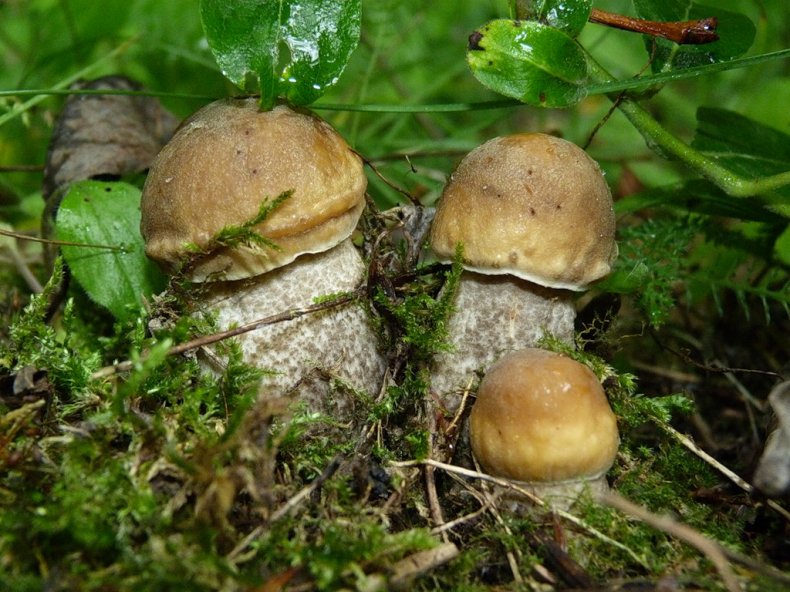
The curved leg has a thickening at the base, up to 4 cm in diameter, up to 13 cm high. The base is painted in a darker color, closer to the cap it is gray-white. As the scales mature, the scales covering the surface of the legs darken, taking on a brownish tint.
The pulp of the fibrous structure of a milky shade, turns pink on the cut, gradually darkening to black.
When planning your mushroom hunting routes, familiarize yourself with edible (growing in May and autumn) and poisonous species of mushrooms.
The spore powder of the gray boletus is dark brown, the spores form a symbiosis with the root system of deciduous trees and shrubs: hazelnuts, poplar, birch, but most often with a hornbeam, as the name suggests.
Most common in wooded areas of the Caucasus, the fruiting period is from June to September inclusive.
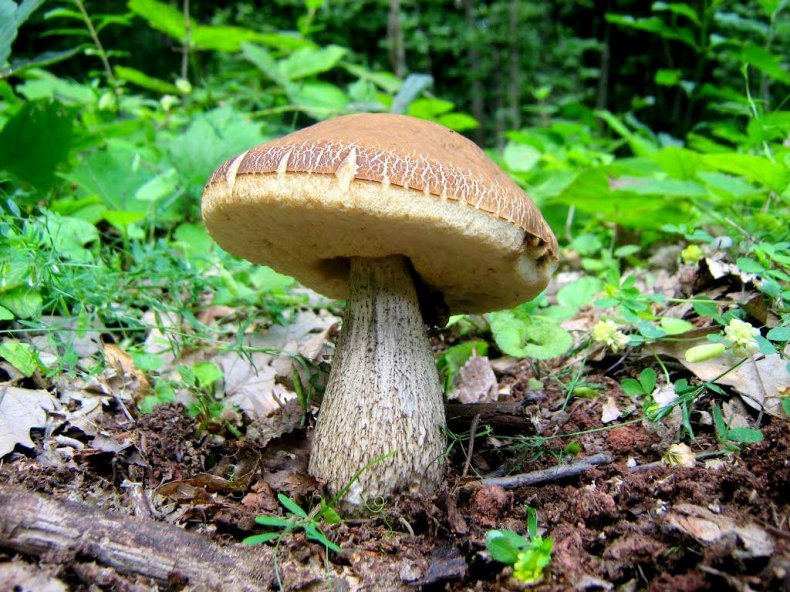
Blackening obbok
Few people collect black butterflies: it is edible, but there is some chemical aftertaste. More often it is pickled or dried for later use as a seasoning.
A round hat of yellowish color with a mesh pattern has a semicircular shape, the skin that covers it can be smooth or felt. Its diameter is, on average, 10 cm.
The leg is up to 12 cm in length and up to 3 cm in the volume of a cylindrical shape with a thickening towards the base. The color is off-white with gray-yellow splashes.
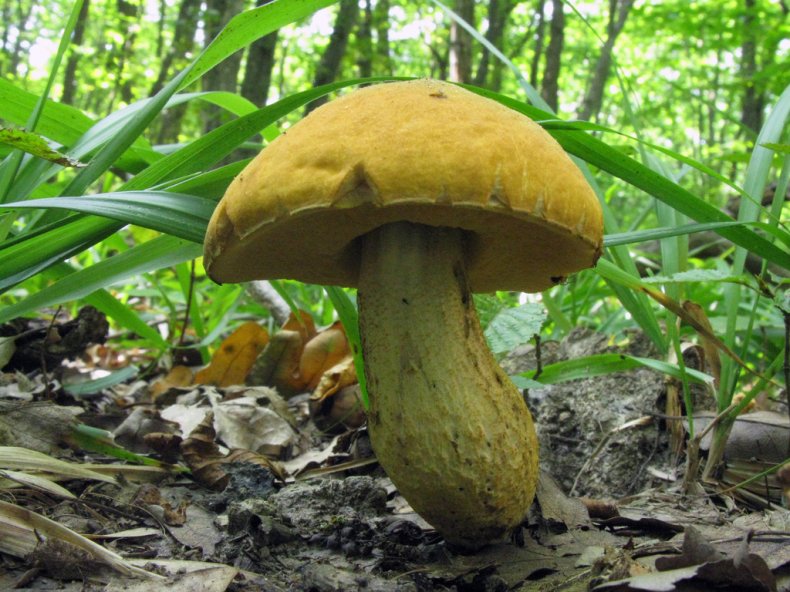
The pulp is light yellow, if broken, it turns red, after - black.
Spore powder of yellow-green hue, forms a symbiosis with beech and oak.
Distribution area - Europe, Caucasus, Carpathian forests.
Important! It is easy for an inexperienced person to confuse edible stumps with satanic and gall mushrooms, which are poisonous. In case of poisoning, the victim must be taken to a medical facility as soon as possible.
Far Eastern obabok
Edible stump, suitable for roasting, stewing and boiling, can be dried for winter use. The loose pulp needs seasoning, since it does not differ in a pronounced mushroom taste and smell.
The cap of an adult mushroom is in the shape of a hemisphere; in dry weather, it can crack, exposing the white flesh. The diameter as they grow up reaches 25 cm. In young animals, the shape is more convex with slight wrinkles, the edges are pressed against the leg. The color is brownish-buffy.

The leg is dense, high, up to 13 cm, and about 3 cm thick. The color is uniform brown-ocher.
As it ripens, the pulp becomes less dense, at the cut it changes color from off-white to pink.
Light brown spores form a mycelium with deciduous, most often with oak.
They are harvested in the Primorsky Territory of the Far East from August to September.
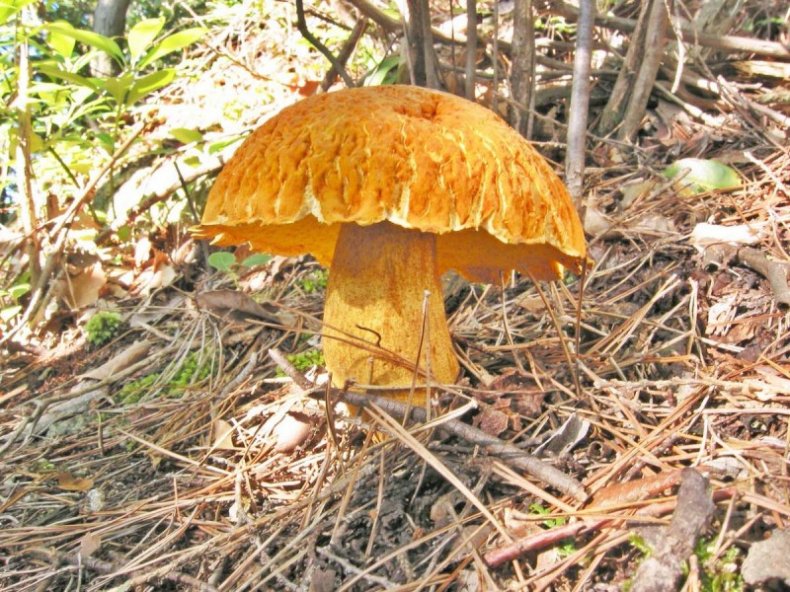
Use
Since the taste of gourmet fruiting bodies is second only to porcini mushrooms, buttocks are really used everywhere in cooking. Boiled mushrooms are added to salads and snacks, birch and aspen trees are fried and consumed with potatoes and meat, their legs and caps give an unusual and very pleasant taste to hot soups. Also, fruiting bodies are often dried and marinated for the winter - you can enjoy the taste of the stump even in the cold winter months.
Edible fruiting bodies do not require any special processing before cooking. You do not need to soak them, you just need to clean the mushrooms from debris, remove the skin from the stem and cut off the tubular layer on the cap. After that, the raw materials are washed and immediately sent to boil in salted water for 30-40 minutes, and after the first 5 minutes of cooking, the water is drained and replaced with fresh water.
In addition to cooking, birch and aspen trees are used for medical purposes. They are offered to use many folk health recipes. It is believed that infusions and tinctures on these mushrooms:
- have a beneficial effect on kidney health;
- help get rid of inflammatory ailments;
- have a good effect on diabetes;
- have a calming and relaxing effect.
Low-calorie lumps can be found in weight loss diets. Due to their high protein content, aspen and birch trees nourish well and help get rid of hunger. But it is impossible to gain weight on mushrooms provided proper nutrition, so the effect for weight loss will only be positive.
Benefits and harm to the body
In cooking, obabki are valued not only for their pleasant taste. Mushrooms of this genus have a beneficial effect on the body, since they contain many useful compounds. The mushroom pulp contains:
- vitamins - B1 and B2, PP;
- vitamins E and D;
- ascorbic acid and thiamine;
- potassium and iron;
- magnesium and phosphorus;
- manganese and calcium;
- amino acids - arginine, glutamine and leucine;
- cellulose;
- a huge amount of vegetable protein.
The beneficial effect of boletus on the body is expressed in the fact that boletus and aspen mushrooms:
- help to improve blood composition and build muscle mass;
- improve metabolism and help the body get rid of toxins;
- equalize blood sugar levels and remove toxins;
- normalize the functioning of the liver and kidneys;
- make up for the lack of vitamins and mineral salts;
- stimulates the immune system and strengthens resistance to disease.
At the same time, with careless use, mushrooms can show their harmful qualities. First of all, they are not advised to use them in the presence of individual intolerance, in this case, even a small amount of mushroom pulp will lead to poisoning
Also, it is not recommended to eat obabki:
- with pancreatitis and ulcers in a state of exacerbation;
- with frequent constipation and sluggish digestion.
Attention! It is better not to offer mushrooms to children under 7 years old, although they are completely harmless, they contain too much protein, and it will be difficult for a sensitive stomach to digest them.
Leccinum albostipitatum
Synonyms: Leccinum rufum, Krombholzia aurantiaca subsp rufa, Boletus rufus, Boletus aurantius var rufus.
A beautiful, prominent mushroom with an orange cap and a white leg covered with scales that darken with age. It is found in aspen forests and forests mixed with aspen, fully justifying its name.



